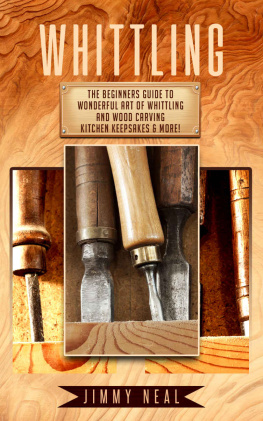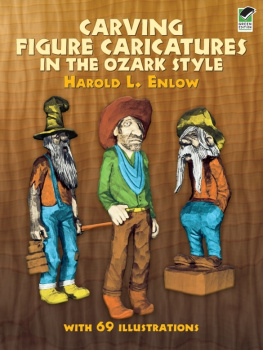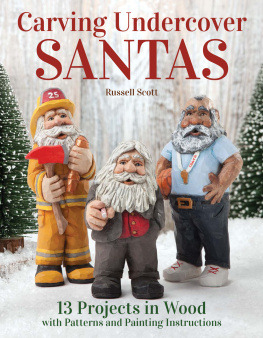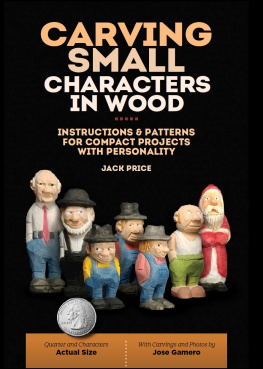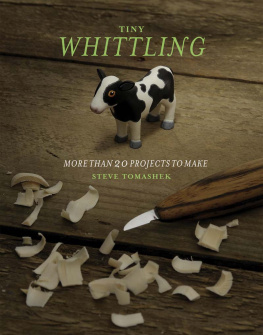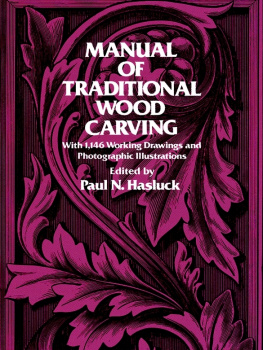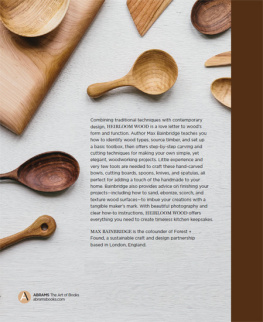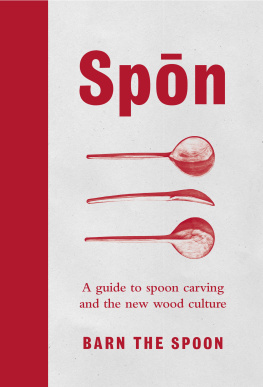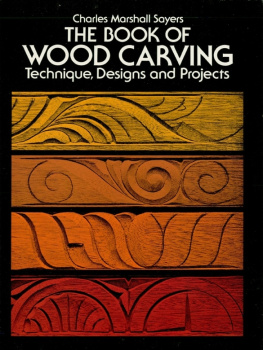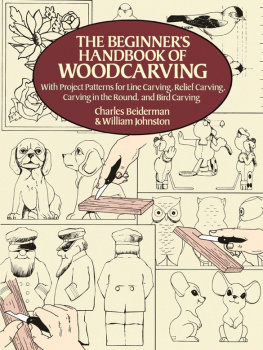David Denning - Wood-Carving for Amateurs: A Practical Handbook for the Novice Worker
Here you can read online David Denning - Wood-Carving for Amateurs: A Practical Handbook for the Novice Worker full text of the book (entire story) in english for free. Download pdf and epub, get meaning, cover and reviews about this ebook. year: 2016, publisher: Read Books Ltd., genre: Romance novel. Description of the work, (preface) as well as reviews are available. Best literature library LitArk.com created for fans of good reading and offers a wide selection of genres:
Romance novel
Science fiction
Adventure
Detective
Science
History
Home and family
Prose
Art
Politics
Computer
Non-fiction
Religion
Business
Children
Humor
Choose a favorite category and find really read worthwhile books. Enjoy immersion in the world of imagination, feel the emotions of the characters or learn something new for yourself, make an fascinating discovery.

- Book:Wood-Carving for Amateurs: A Practical Handbook for the Novice Worker
- Author:
- Publisher:Read Books Ltd.
- Genre:
- Year:2016
- Rating:3 / 5
- Favourites:Add to favourites
- Your mark:
- 60
- 1
- 2
- 3
- 4
- 5
Wood-Carving for Amateurs: A Practical Handbook for the Novice Worker: summary, description and annotation
We offer to read an annotation, description, summary or preface (depends on what the author of the book "Wood-Carving for Amateurs: A Practical Handbook for the Novice Worker" wrote himself). If you haven't found the necessary information about the book — write in the comments, we will try to find it.
David Denning: author's other books
Who wrote Wood-Carving for Amateurs: A Practical Handbook for the Novice Worker? Find out the surname, the name of the author of the book and a list of all author's works by series.
Wood-Carving for Amateurs: A Practical Handbook for the Novice Worker — read online for free the complete book (whole text) full work
Below is the text of the book, divided by pages. System saving the place of the last page read, allows you to conveniently read the book "Wood-Carving for Amateurs: A Practical Handbook for the Novice Worker" online for free, without having to search again every time where you left off. Put a bookmark, and you can go to the page where you finished reading at any time.
Font size:
Interval:
Bookmark:
A PRACTICAL HANDBOOK
FOR THE NOVICE WORKER.
ILLUSTRATED.
By DAVID DENNING,
Author of Fretwork and Marqueterie. &c.
FOURTH EDITION.
Revised and Enlarged by CHARLES F. CALLOW, A.R.I.B.A.
Copyright 2013 Read Books Ltd.
This book is copyright and may not be reproduced or copied in any way without the express permission of the publisher in writing
British Library Cataloguing-in-Publication Data
A catalogue record for this book is available from the British Library
Woodworking is the process of making items from wood. Along with stone, mud and animal parts, wood was one of the first materials worked by early humans. There are incredibly early examples of woodwork, evidenced in Mousterian stone tools used by Neanderthal man, which demonstrate our affinity with the wooden medium. In fact, the very development of civilisation is linked to the advancement of increasingly greater degrees of skill in working with these materials.
Examples of Bronze Age wood-carving include tree trunks worked into coffins from northern Germany and Denmark and wooden folding-chairs. The site of Fellbach-Schmieden in Germany has provided fine examples of wooden animal statues from the Iron Age. Woodworking is depicted in many ancient Egyptian drawings, and a considerable amount of ancient Egyptian furniture (such as stools, chairs, tables, beds, chests) has been preserved in tombs. The inner coffins found in the tombs were also made of wood. The metal used by the Egyptians for woodworking tools was originally copper and eventually, after 2000 BC, bronze - as ironworking was unknown until much later. Historically, woodworkers relied upon the woods native to their region, until transportation and trade innovations made more exotic woods available to the craftsman.
Today, often as a contemporary artistic and 'craft' medium, wood is used both in traditional and modern styles; an excellent material for delicate as well as forceful artworks. Wood is used in forms of sculpture, trade, and decoration including chip carving, wood burning, and marquetry, offering a fascination, beauty, and complexity in the grain that often shows even when the medium is painted. It is in some ways easier to shape than harder substances, but an artist or craftsman must develop specific skills to carve it properly. 'Wood carving' is really an entire genre itself, and involves cutting wood generally with a knife in one hand, or a chisel by two hands - or, with one hand on a chisel and one hand on a mallet. The phrase may also refer to the finished product, from individual sculptures to hand-worked mouldings composing part of a tracery.
The making of sculpture in wood has been extremely widely practiced but survives much less well than the other main materials such as stone and bronze, as it is vulnerable to decay, insect damage, and fire. It therefore forms an important hidden element in the arts and crafts history of many cultures. Outdoor wood sculptures do not last long in most parts of the world, so that we have little idea how the totem pole tradition developed. Many of the most important sculptures of China and Japan in particular are in wood, and the great majority of African sculptures and that of Oceania also use this medium. There are various forms of carving which can be utilised; 'chip carving' (a style of carving in which knives or chisels are used to remove small chips of the material), 'relief carving' (where figures are carved in a flat panel of wood), 'Scandinavian flat-plane' (where figures are carved in large flat planes, created primarily using a carving knife - and rarely rounded or sanded afterwards) and 'whittling' (simply carving shapes using just a knife). Each of these techniques will need slightly varying tools, but broadly speaking, a specialised 'carving knife' is essential, alongside a 'gouge' (a tool with a curved cutting edge used in a variety of forms and sizes for carving hollows, rounds and sweeping curves), a 'chisel' and a 'coping saw' (a small saw, used to cut off chunks of wood at once).
Although this is probably the most ancient, and still the most widely practiced form of decorative woodwork, there remains several other popular techniques. Working with veneer is relatively common - and in woodworking, 'veneer' refers specifically to thin slices of wood, usually thinner than 3 mm (1/8 inch), glued onto core panels (typically, wood, particle board or medium-density fiberboard) to produce flat panels such as doors, tops and panels for cabinets, parquet floors and parts of furniture. Veneer is obtained either by 'peeling' the trunk of a tree or by slicing large rectangular blocks of wood known as flitches. There are three main types of veneer-making equipment used commercially: A rotary lathe in which the wood is turned against a very sharp blade and peeled off in one continuous or semi-continuous roll. A slicing machine in which the flitch or piece of log is raised and lowered against the blade and slices of the log are made. And last but not least, a half-round lathe in which the log or piece of log can be turned and moved in such a way as to expose the most interesting parts of the grain.
Each slicing processes gives a very distinctive type of grain, depending upon the tree species. In any of the veneer-slicing methods, when the veneer is sliced, a distortion of the grain occurs. As it hits the wood, the knife blade creates a 'loose' side where the cells have been opened up by the blade, and a 'tight' side. The technique of using veneer is additionally used in Marquetry; more particularly the art and craft of applying pieces of veneer to a structure to form decorative patterns, designs or pictures. The technique may be applied to case furniture or even seat furniture, to decorative small objects with smooth, veneerable surfaces or to freestanding pictorial panels appreciated in their own right. Parquetry is similar in technique to marquetry; in the former the pieces of veneer are of simple repeating geometric shapes, forming tiling patterns such as would cover a floor (parquet), or forming basketweave or brickwork patterns, trelliswork and the like.
Marquetry (and parquetry too) again differ from the more ancient craft of inlay, or intarsia, in which a solid body of one material is cut out to receive sections of another to form the surface pattern. The word derives from a Middle French word meaning 'inlaid work'. The veneers used are primarily woods, but may include bone, ivory, turtle-shell (conventionally called 'tortoiseshell'), mother-of-pearl, pewter, brass or fine metals. Marquetry using coloured straw was a specialty of some European spa resorts from the end of the eighteenth century. Many exotic woods as well as common European varieties can be employed, from the near-white of boxwood to the near-black of ebony, with veneers that retain stains well, like sycamore, dyed to provide colours not found in nature. Marquetry as a modern craft most commonly uses knife-cut veneers. However, the knife-cutting technique usually requires a lot of time. For that reason, many marquetarians have switched to fret (an interlaced decorative design that is either carved in low relief on a solid background, or cut out with a fretsaw, coping saw, jigsaw or scroll saw) techniques.
As is evident from this brief historical and practical overview of decorative woodwork, it is an incredibly varied and exciting genre of arts and crafts; an ancient tradition still relevant in the modern day. Woodworkers range from hobbyists, individuals operating from the home environment, to artisan professionals with specialist workshops, and eventually large-scale factory operations. We hope the reader is inspired by this book to create some woodwork of their own.
Font size:
Interval:
Bookmark:
Similar books «Wood-Carving for Amateurs: A Practical Handbook for the Novice Worker»
Look at similar books to Wood-Carving for Amateurs: A Practical Handbook for the Novice Worker. We have selected literature similar in name and meaning in the hope of providing readers with more options to find new, interesting, not yet read works.
Discussion, reviews of the book Wood-Carving for Amateurs: A Practical Handbook for the Novice Worker and just readers' own opinions. Leave your comments, write what you think about the work, its meaning or the main characters. Specify what exactly you liked and what you didn't like, and why you think so.

